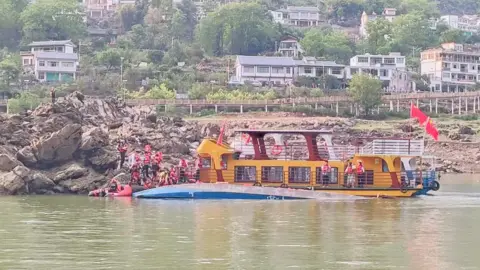On May 5, 2025, a tragic incident unfolded in southwestern China, leading to the death of at least ten individuals and the hospitalization of around 70 others. This calamity occurred when four tourist boats capsized in a river situated in Qianxi city, Guizhou province, as unexpected strong winds swept through the area. Reports from state media indicated that a total of 84 people fell into the tumultuous waters as the boats overturned. The unfortunate death toll rose from a preliminary nine to ten after rescue teams recovered the body of a missing individual the following day.
The incident took place during a peak travel season—right at the tail end of China’s week-long May Day holiday. This period typically sees increased activity in tourism, with many citizens partaking in leisure trips across various destinations. As the chaos unfolded, the Chinese leadership, including President Xi Jinping, immediately called for “all-out efforts” towards search and rescue operations. There is a growing recognition that such tragic events in the realm of tourism could have been mitigated with adequate safety measures in place.
Following this incident, President Xi noted the pressing need for heightened safety protocols, especially in light of a series of similar occurrences reported across the nation. Authorities were directed to step up public safety initiatives during what is conventionally considered a peak season for tourism, thereby ensuring that tourist attractions provide safe environments for visitors.
Just a couple of months prior to this disaster, another maritime incident claimed the lives of 11 people in Hunan province when a passenger boat collided with an industrial vessel. Moreover, coincidentally, the weekend preceding the capsize saw another accident when a sightseeing helicopter crashed into a newly opened park in Suzhou. This particular crash resulted in one fatality and injuries to four others on board. These incidents raise urgent questions about the safety regulations and enforcement surrounding travel and recreational activities within the country.
The combination of adverse weather conditions and the large number of people involved likely exacerbated the tragedy in Qianxi. Eyewitness accounts and emergency response plans need to be scrutinized to determine the effectiveness and preparedness of local authorities in responding to such emergencies. It’s critical that tourism operators and local government offices take proactive measures to educate tourists on safety and emergency procedures, particularly when weather forecasts predict adverse conditions.
The repercussions of this disaster will undoubtedly ripple throughout the tourism industry in China, prompting a reevaluation of safety practices not just for boats but for all modes of transportation often used by tourists. As investigations begin, the overarching emphasis will likely be on ensuring that no further loss of life occurs during similar holiday periods. Increased oversight and a commitment to safety improvements could help restore public confidence in the safety of Chinese tourist attractions.
As this situation unfolds, families affected by the tragedy will be seeking answers and closure, while the national government will be under pressure to address the broader implications for public safety during a time when tourism is increasingly pivotal to China’s economic landscape. The balancing act between promoting tourism and ensuring safety is an intricate challenge that authorities must navigate with diligence and compassion for the lives disrupted by this tragic event.



